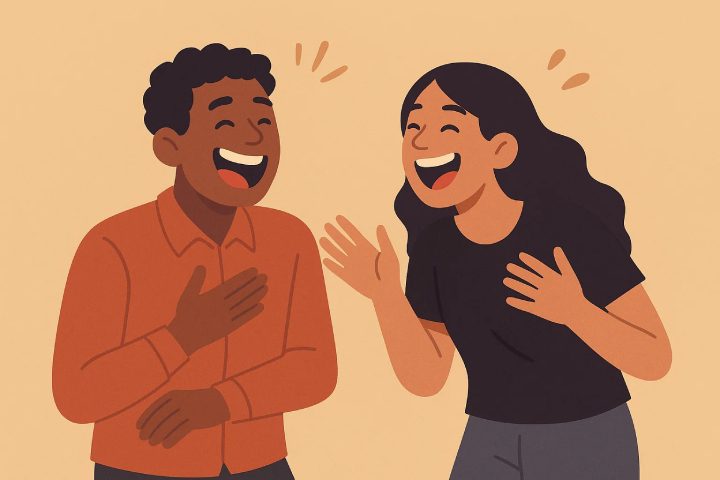We can all agree that laughing is one of the ways people connect. And one of the best ways to bring laughter is with hilarious jokes. A good joke can instantly lift the spirit. So, whether you are stuck in a long, boring meeting, feeling stressed, or just want to make your day, a good joke can lighten up your mood.
What makes hilarious jokes so effective
Hilarious jokes are not just instant laughs; they really affect our minds and bodies. For example, when we hear something really funny, we feel instant pleasure, and our brain releases endorphins. Endorphins are “feel-good” chemicals that can improve your mood. It lightens up the mood; that’s why, even a single gook joke can transform your stressful day into a good one.
Sometimes, it helps you create a sense of connection between people where there are just words and boring talks.
In addition, sharing funny things can relax your mind and boost your creativity. You get new ideas and fresh solutions to your problems. It has been observed that people often solve tricky challenges more effectively when they are in a good mood.



You may have noticed that when a group of people is just sitting quietly, someone suddenly says something funny that quickly changes the whole environment. So, good jokes are icebreakers. They ease tension in classrooms, meetings, social or family gatherings. They can turn boring conversations into enjoyable ones. Well, good jokes can make moments memorable, leaving a lasting impact on people.
So, we can say that hilarious jokes can boost your mood, help you connect with people, and improve your creativity. Yes, they are far beyond a simple chuckle.
How do hilarious jokes benefit social interaction
To boost social interactions, humor is very beneficial. In this section, we will see how it works.
Breaking the ice in conversations:
As we discussed, a good joke can lighten up the environment. It can relieve stress after a meeting. You know, a conversation full of frankness and jokes can help others feel relaxed. People start chatting naturally, in a good mood.
Making group settings more relaxed:
In group settings, such as offices, classrooms, and gatherings, hilarious jokes can ease tension. With an instant joke, people laugh together, creating a pleasant, friendly atmosphere. It releases stiffness.
Strengthening connections through laughter:
You may have noticed that people who share fun things with others are often more connected. They build trust and closeness. They create more memories that leave a lasting impact on the audience’s hearts.
Enhancing communication: In a stiff environment, people can’t express themselves freely. Humour helps people express their words more frankly. A good, relaxed environment boosts people’s confidence, and they share their ideas more confidently.
Releasing tension and resolving conflicts: A good joke at the right time can save a connection. It can reduce stress during conflicts. Due to a humorous line, people step back from disagreement and try to sort things out in a lighter way. Well, we can say it is a good way to ease the tension without disrespecting or offending anybody involved.
Discovering hilarious jokes for every audience
The same joke is not for everyone. Different jokes have different impacts on different age groups. Some jokes feel funny to kids, but are idle for tennis or adults. If you know the types of jokes, you will be able to pick the right one that will suit the taste of your audience. In this section, we will look at jokes based on different age groups.
- Knock-Knock jokes: These jokes are best for casual gatherings or kids. For example: “Knock, knock”. “Who’s there?” “Lettuce.” “Lettuce who?”
- Dad jokes: These jokes are charming and groan-worthy. Usually, teens and adults love these jokes. For example: “Look! Skeletons are fighting each other.”
- Puns and wordplay: These are a type of clever joke. They twist meanings or words. For example: “I am learning anti-gravity. You can’t put me down now!”
- Animal jokes: These jokes are based on pets and wildlife—basically, funny lines about them. For example: “Why did the rabbit lose the race? He was dreaming of winning while sleeping.”
- Riddles: These jokes tease the brain into thinking and then laughing. They make you think for a while, and you catch, you will laugh instantly. For example: “What is the thing that has a key but can’t open a lock? A Piano.”
- Observational humour: These jokes relate to everyone sitting in the audience. They are about everyday life. For example: “Why do we keep pressing the button on the remote for long again and again even after knowing that the battery is dead?”
- Clean teen jokes: Relatable, fun, and appropriate for teens. For example: “You know, why students eat their homework? Because the teacher said it’s just a piece of cake.”
With these jokes, you can have an idea that, within respect and manners, how versatile a joke can be. So, whether you want a clever joke or a joke that can relate to every audience, there’s a joke to change the environment.
Hilarious jokes for kids: Clean, clever, and captivating
Making good memories: Humor can make an ordinary moment into a memorable one. A group laugh can be remembered for many years ot come. You may have noticed that our elders often said that, in our time, we were sitting together, laughing like crazy over useless things. So, laughter leaves a mark on the mind and heart more than a serious discussion.
Classic knock-knock jokes
These jokes are especially for kids. They are just simple, fun, and easy. Moreover, they are not hard to remember. These jokes are suitable for a family gathering to get a giggle. These jokes are so easy that kids often learn the sentences and share them with their friends. So, it creates more fun.
Example: “Knock, knock.” “Who’s there?” “Boo.” “Boo who?” “Don’t cry, it’s just a joke!”
Animal antics
You know, usually kids love animals. Therefore, they love animals because they are imaginable. Funny stories about animals spark laughter among kids while remaining innocent. Well, you can use these jokes at home, too.
Example: “Why did the ducks go to the seance? To talk to the other side!”
Riddles and wordplay
Riddle jokes are best for kids. They make them think, which boosts their creativity and problem–solving skills. Honestly, kids enjoy this type of joke; it adds excitement to the fun.
Example: “What has three spoons and 12 sweets, but can’t eat? A clock.”
Hilarious dad jokes: Groan-worthy gems that bring smiles
Unique charm and appeal
Dad jokes are a bit cheesy but enjoyable. They are silly, simple, and charming. These jokes have the power to lighten up the whole room in a few seconds.
For example;
“I know just 25 letters of the English alphabet. I don’t know why.”
“Why did the camels win an award? Because they were outstanding in their field!”
“I’m studying anti-gravity. It’s impossible to put down!”
Hilarious short jokes: Quick wit for any moment
Quick, Bike-sized fun
When you don’t have much time but want to make the moment joyful, at those times, short jokes are perfect. These jokes can also be shared over social media, texts, or in a chat box. A quick joke can make a dull moment brighter.
Examples of Top Short Jokes
“I told my PC I want a break. It said ‘No problem, let’s go to sleep.’”
“I’m on a seafood diet. I just see food, and I eat all the food.”
“Why don’t eggs share jokes? They can crack while cheering up.”
Hilarious jokes for teens: Relatable, witty, and age-appropriate
Understanding teen humor
These jokes involve irony, pop culture, and sarcasm. These jokes relate to the lives of teens. Even a small reference to their school life or ongoing trend makes them laugh out loud.
Finding humor that resonates
Jokes should be fun but innocent. They should not mean to offend or disrespect someone. These jokes involve social media, friends, and homework. You know, teens are obsessed with jokes they can share online with their friends.
Examples:
“Can you transform this reel content into real?”
“My homework and I have a long-distance relationship. We just don’t see each other.”
“I told my Wi-Fi we needed to talk, and now we’re not connected anymore.”
Hilarious jokes for Adults: Sophisticated, intelligent, and clean fun
Adult comedy
Observational jokes often explore practical life frustrations, the realities of life, and ironic situations. These are relatable to real moments in adult life.
Example: “How dumb we are to call it ‘quick break’ even though it takes one hour to bake.”
Inclusive and respectful humor
After knowing the different types of jokes of different age groups, you will be wondering how to deliver them. Sharing a joke is not just saying those words. It should be delivered humorously and at a specific time. Not all hours are joke hours. In this section, we will discuss how to deliver hilarious jokes naturally.
Tips for telling hilarious jokes naturally
After knowing the different types of jokes of different age groups, you will be wondering how to deliver them. Sharing a joke is not just saying those words. It should be delivered humorously and at a specific time. Not all hours are joke hours. In this section, we will discuss how to deliver hilarious jokes naturally.



Understanding your audience
First, you should know who you will be talking to. You know, tastes differ among kids, teens, and adults. Therefore, pay attention to the age group and comfort level. Well, a joke may fit best with friends, but not in a professional meeting.
Using delivery, tone, and timing
The way of telling a joke is equally important as the joke itself. Speak clearly and try to use a playful tone. Moreover, you take small pauses for effect. Apart from this, timing is also an important factor in making a joke joyful or fall flat.
Avoiding offensive or awkward jokes
As we discussed, don’t use jokes that hurt the feelings of anyone. Your jokes should not make anybody feel uncomfortable. Therefore, you should avoid sensitive topics or personal attacks. A good joke makes everybody laugh without stressing the environment. One more thing: keep in mind how the other person might react before sharing.
Practice makes perfect
Practice makes man perfect! It can happen that you share a joke and nobody laughs with the energy you expect. But try spreading laughter, and one day you will be able to make everybody in your audience smile. You will feel confident and normal while sharing even adult jokes.
Navigating humor online: Keeping it safe and respectful
In today’s world, kids often use online platforms and communities filled with jokes, memes, and trends. Kids, because of immaturity, don’t understand their meanings, and just pressure to fit in, try these jokes online. As a parent, you should stay cautious and help them understand respectful boundaries.
Understanding appropriate humor for all ages
First of all, there is a strong need for younger kids to understand that jokes range from harmless to adult ones. It’s important to note that problems arise with humor only when it mocks other identities or spreads harmful ideas. This is because it damages others’ self-esteem and may contribute to real-world discrimination.
Similarly, jokes with explicit or sexual themes are also inappropriate for kids since they would expose them to immature content. You know this early exposure mentally disturbs them and negatively shapes how they understand relationships and respect.
When you guide kids to understand that jokes are just to bring smiles to other people’s faces, not to embarrass or disrespect, trust me! They would truly develop empathy, kindness, and safer digital interactions.
Identifying and avoiding potentially harmful content
Teaching critical thinking about online humor sources: You should clearly make your kids understand that whenever they come across any joke online or from their friend. They first check where it comes from and what its intention is. Tell them that if they are struggling to understand, then they will come to you.
Understanding the impact of jokes: Furthermore, teach your kids that although you’re saying anything jokingly, it might hurt others’ feelings. Nothing can substitute if someone gets emotionally damaged, okay!
Resources for reporting and blocking unsafe content: Last but not least, guide your kids to report any disrespectful content they find immediately. Give them the example of Instagram: you’ll just tap the three-dot icon at the top of the post, then tap the report option from the list. This way, kids would become independent and make their digital space safe from Internet toxicity.
Conclusion
From all the above discussions, we have concluded that having a good sense of humor is really important for social interaction. However, while humorous people need to understand boundaries and make sure they’re not disrespecting others, you should also teach your kids this and equip them with strategies for reporting or blocking unsafe content to ensure a safe digital environment.

